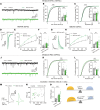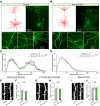Ppp2r1a haploinsufficiency increases excitatory synaptic transmission and decreases spatial learning by impairing endocannabinoid signaling
- PMID: 40839403
- PMCID: PMC12404745
- DOI: 10.1172/JCI185602
Ppp2r1a haploinsufficiency increases excitatory synaptic transmission and decreases spatial learning by impairing endocannabinoid signaling
Abstract
Protein phosphatase 2A (PP2A) is a serine/threonine phosphatase in the brain. Mutations in PPP2R1A, encoding the scaffolding subunit, are linked to intellectual disability, although the underlying mechanisms remain unclear. This study examined mice with heterozygous deletion of Ppp2r1a in forebrain excitatory neurons (NEX-het-conditional knockout [NEX-het-cKO]). These mice exhibited impaired spatial learning and memory, resembling Ppp2r1a-associated intellectual disability. Ppp2r1a haploinsufficiency also led to increased excitatory synaptic strength and reduced inhibitory synapse numbers on pyramidal neurons. The increased excitatory synaptic transmission was attributed to increased presynaptic release probability, likely due to reduced levels of 2-arachidonoyl glycerol (2-AG). This reduction in 2-AG was associated with increased transcription of monoacylglycerol lipase (MAGL), driven by destabilization of enhancer of zeste homolog 2 (EZH2) in NEX-het-cKO mice. Importantly, the MAGL inhibitor JZL184 effectively restored both synaptic and learning deficits. Our findings uncover an unexpected role of PPP2R1A in regulating endocannabinoid signaling, providing fresh molecular and synaptic insights into the mechanisms underlying intellectual disability.
Keywords: Development; Intellectual disability; Neurodevelopment; Neuroscience; Synapses.
Figures










Comment in
- Unraveling endocannabinoid signaling disruption in a preclinical model of neurodevelopmental disorders doi: 10.1172/JCI196707
References
MeSH terms
Substances
LinkOut - more resources
Full Text Sources
Molecular Biology Databases
Miscellaneous

